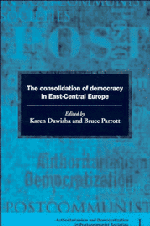Book contents
- Frontmatter
- Contents
- List of tables
- List of contributors
- Preface
- 1 Perspectives on postcommunist democratization
- 2 Democratization and political participation: research concepts and methodologies
- 3 Democratic consolidation in Poland after 1989
- 4 Party politics and political participation in postcommunist Hungary
- 5 Democratization and political participation: the experience of the Czech Republic
- 6 Democratization and political participation in Slovakia
- 7 Democratization and political participation in postcommunist societies: the case of Latvia
- 8 Democratization in Lithuania
- 9 Democratization and political development in Estonia, 1987–96
- Appendix
- Index
8 - Democratization in Lithuania
Published online by Cambridge University Press: 01 June 2011
- Frontmatter
- Contents
- List of tables
- List of contributors
- Preface
- 1 Perspectives on postcommunist democratization
- 2 Democratization and political participation: research concepts and methodologies
- 3 Democratic consolidation in Poland after 1989
- 4 Party politics and political participation in postcommunist Hungary
- 5 Democratization and political participation: the experience of the Czech Republic
- 6 Democratization and political participation in Slovakia
- 7 Democratization and political participation in postcommunist societies: the case of Latvia
- 8 Democratization in Lithuania
- 9 Democratization and political development in Estonia, 1987–96
- Appendix
- Index
Summary
On March 11, 1990, a newly elected Lithuanian government reclaimed the independent status it lost when the Red Army occupied the country in 1940. Mikhail Gorbachev said the declaration was illegal and tried to force Vytautas Landsbergis, the Lithuanian “president,” to rescind it. Landsbergis refused and Gorbachev imposed an economic embargo upon the small Baltic country. When that failed to influence Landsbergis, Gorbachev launched a coup d'etat against the Lithuanians on January 13, 1991 (“Bloody Sunday”). Fourteen people were killed, but the Soviet forces stopped short of storming the parliament building and removing Landsbergis from power. “Bloody Sunday” precipitated a chain of events which ultimately led to the demise of the USSR in December 1991, the resurrection of the badly demoralized democratic movement in Russia, and a new union treaty which spawned the anti-Gorbachev Putsch of August 1991.
Today Lithuania is struggling to build an open society and the purpose of this paper is to evaluate the problems and prospects of Lithuania's achieving that goal. Toward this end, a pivotal question must be addressed. What are the prospects of Lithuania building a democratic society based upon the rule of law, multiple political parties, universal suffrage, a free press, and a viable civil society in which unions, ethnic organizations, and business enterprises and other voluntary associations operate independently of the state?
- Type
- Chapter
- Information
- The Consolidation of Democracy in East-Central Europe , pp. 289 - 333Publisher: Cambridge University PressPrint publication year: 1997



